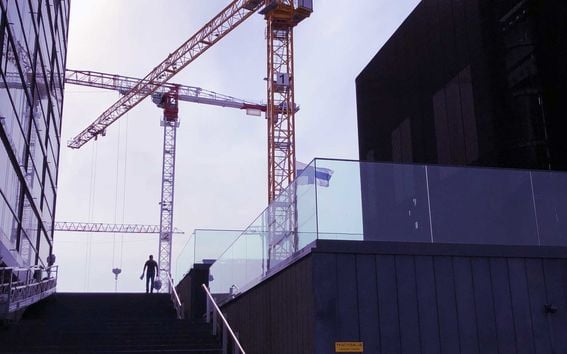How data reveals construction process waste

'We started in 2016 a two-year research project called Intelligent Construction Site (iCONS) with a group of companies. The project examined the use of indoor positioning technologies on a construction site,' says Professor of Practice Olli Seppänen. 'The technology consisted of small key tags or beacons attached to workers, building materials and components. Each space in a building had a device that could track where each beacon was at any given moment.'
The data collected during iCONS revealed interesting facts about what’s happening on a construction site. The project team soon realised that they can use the information to measure process waste in a completely new way.
Waste dominates the working day
Construction workers moved a lot during a day. In fact, they only stayed on their worksite for around 30% of working hours. The newly acquired data coincided with the numbers that students in earlier studies had clocked manually.
Construction site workers spend most of their time doing their core task. In this case, they used 70% of their time collecting materials, searching for tools, looking for instructions, and so on. In lean construction terms, most of their day was process waste.
'We monitored the work of carpenters, plumbers, tile layers, among others, on seven construction sites. We analysed hundreds of thousands of minutes. The value-adding time varied between 25 and 35% when periods of over 10 minutes of non-movement were tallied,' Seppänen explains.
Digging deeper
After iCONS, Seppänen and his team have continued to explore construction process waste and its sources. Building 2030, a business consortium funding research, commissioned Aalto to deepen the knowledge on waste.
In one of the projects, carpenters wore hardhat video cameras to record everything that they did during a workday. The researcher analysed the videos and the recorded discussions, making some interesting discoveries. For example, each contractor, when starting to work on a room, measured it anew, not trusting the previous markings. Finally, the same space had been measured dozens of times.
The workers had to walk a lot. They used 40% of their day collecting materials from the storage on the other side of the building.
The researcher also measured the waste that did not stem from movement. He saw, for example, how long it took to study the design documents. He listened to the discussion about missing information or discrepancies in the plans.
The next stage of the project will test ways to remove waste. It will employ a well-planned workflow, up-to-date documents, and well-organised logistics. The researcher will, then, measure how the changes speed up the process and if they affect employee satisfaction.
Another M.Sc. thesis study uses cameras to record takt production in an area of 400 square meters. 'The assumption in takt production is that, when one team has finished its task in an area, the next one will continue right after. Will that really happen? Are there possibly other people in the area? How will the materials move along? That’s interesting to find out,' says Seppänen.
Further waste in design management and design
Contractors, vendors and manufacturers depend on digital design models and documents of the project. Incorrect or incomplete information creates process waste. Aalto’s research will investigate what information the parties need at each stage and how the information should be presented.
One of the projects analyses structural design processes at A-insinöörit. The research will measure the amount of productive work, the impact of lacking initial information on productivity, revisioning and so on.
'What’s clear by now is that a trade contractor or an individual worker cannot alone reduce waste. The main contractor and designers hold the keys to better productivity,' Seppänen reminds. 'Trade contractors have a capacity to improve productivity if only given the chance.'
Trade contractors already assess the main contractor’s ability and willingness to improve productivity. If a project has a competent superintendent, the trade contractors can bid at a 15-20% lower price than if that’s not the case.
'When it comes to waste, the shortening of project lead time is the most important incentive. It should not be a question of an individual in charge, but a result of systematised processes,” Seppänen points out. 'Data helps us identify the sources and impacts of waste. One day, we’ll be able to verify the productivity of construction in real-time and show the improvement at the end of each day,' he envisions.
- Published:
- Updated:
Read more news

DeployAI Partners Gather for Heart Beat Meeting in Helsinki
The European DeployAI project's partners gathered for the Heart Beat meeting hosted by Aalto University Executive Education in Helsinki.
Get to know us: Associate Professor Maria Sammalkorpi
Sammalkorpi received her doctorate from Helsinki University of Technology 2004. After her defence, she has worked as a researcher at the Universities of Princeton, Yale and Aalto.
Aalto computer scientists in ICML 2024
Computer scientists in ICML 2024